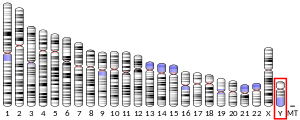UTY (gene)
Histone demethylase UTY is an enzyme that in humans is encoded by the UTY gene.[3][4][5]
This gene encodes a protein containing tetratricopeptide repeats which are thought to be involved in protein-protein interactions. This protein is a minor histocompatibility antigen which may induce graft rejection of male stem cell grafts. Alternative splicing results in multiple transcript variants encoding different isoforms.[5]
Interactions
UTY (gene) has been shown to interact with TLE1,[6] and WDR90[7]
References
- 1 2 3 GRCh38: Ensembl release 89: ENSG00000183878 - Ensembl, May 2017
- ↑ "Human PubMed Reference:".
- ↑ Greenfield A, Scott D, Pennisi D, Ehrmann I, Ellis P, Cooper L, Simpson E, Koopman P (Jan 1997). "An H-YDb epitope is encoded by a novel mouse Y chromosome gene". Nat Genet. 14 (4): 474–478. doi:10.1038/ng1296-474. PMID 8944031.
- ↑ Greenfield A, Carrel L, Pennisi D, Philippe C, Quaderi N, Siggers P, Steiner K, Tam PP, Monaco AP, Willard HF, Koopman P (May 1998). "The UTX gene escapes X inactivation in mice and humans". Hum Mol Genet. 7 (4): 737–742. doi:10.1093/hmg/7.4.737. PMID 9499428.
- 1 2 "Entrez Gene: UTY ubiquitously transcribed tetratricopeptide repeat gene, Y-linked".
- ↑ Grbavec, D; Lo R; Liu Y; Greenfield A; Stifani S (Jan 1999). "Groucho/transducin-like enhancer of split (TLE) family members interact with the yeast transcriptional co-repressor SSN6 and mammalian SSN6-related proteins: implications for evolutionary conservation of transcription repression mechanisms". Biochem. J. ENGLAND. 337 (1): 13–7. doi:10.1042/0264-6021:3370013. ISSN 0264-6021. PMC 1219929. PMID 9854018.
- ↑ "STRING: functional protein association networks". string-db.org. Retrieved 2015-05-07.
Further reading
- Lahn BT, Page DC (1997). "Functional coherence of the human Y chromosome". Science. 278 (5338): 675–680. Bibcode:1997Sci...278..675L. doi:10.1126/science.278.5338.675. PMID 9381176.
- Grbavec D, Lo R, Liu Y, et al. (1999). "Groucho/transducin-like enhancer of split (TLE) family members interact with the yeast transcriptional co-repressor SSN6 and mammalian SSN6-related proteins: implications for evolutionary conservation of transcription repression mechanisms". Biochem. J. 337 (1): 13–7. doi:10.1042/0264-6021:3370013. PMC 1219929. PMID 9854018.
- Warren EH, Gavin MA, Simpson E, et al. (2000). "The human UTY gene encodes a novel HLA-B8-restricted H-Y antigen". J. Immunol. 164 (5): 2807–14. doi:10.4049/jimmunol.164.5.2807. PMID 10679124.
- Foresta C, Ferlin A, Moro E (2000). "Deletion and expression analysis of AZFa genes on the human Y chromosome revealed a major role for DBY in male infertility". Hum. Mol. Genet. 9 (8): 1161–1169. doi:10.1093/hmg/9.8.1161. PMID 10767340.
- Shen P, Wang F, Underhill PA, et al. (2000). "Population genetic implications from sequence variation in four Y chromosome genes". Proc. Natl. Acad. Sci. U.S.A. 97 (13): 7354–7359. Bibcode:2000PNAS...97.7354S. doi:10.1073/pnas.97.13.7354. PMC 16549. PMID 10861003.
- Vogt MH, Goulmy E, Kloosterboer FM, et al. (2000). "UTY gene codes for an HLA-B60-restricted human male-specific minor histocompatibility antigen involved in stem cell graft rejection: characterization of the critical polymorphic amino acid residues for T-cell recognition". Blood. 96 (9): 3126–32. PMID 11049993.
- Strausberg RL, Feingold EA, Grouse LH, et al. (2003). "Generation and initial analysis of more than 15,000 full-length human and mouse cDNA sequences". Proc. Natl. Acad. Sci. U.S.A. 99 (26): 16899–16903. Bibcode:2002PNAS...9916899M. doi:10.1073/pnas.242603899. PMC 139241. PMID 12477932.
- Gevaert K, Goethals M, Martens L, et al. (2004). "Exploring proteomes and analyzing protein processing by mass spectrometric identification of sorted N-terminal peptides". Nat. Biotechnol. 21 (5): 566–569. doi:10.1038/nbt810. PMID 12665801.
- Skaletsky H, Kuroda-Kawaguchi T, Minx PJ, et al. (2003). "The male-specific region of the human Y chromosome is a mosaic of discrete sequence classes". Nature. 423 (6942): 825–837. Bibcode:2003Natur.423..825S. doi:10.1038/nature01722. PMID 12815422.
- Agate RJ, Choe M, Arnold AP (2004). "Sex differences in structure and expression of the sex chromosome genes CHD1Z and CHD1W in zebra finches". Mol. Biol. Evol. 21 (2): 384–396. doi:10.1093/molbev/msh027. PMID 14660691.
- Gerrard DT, Filatov DA (2005). "Positive and negative selection on mammalian Y chromosomes". Mol. Biol. Evol. 22 (6): 1423–1432. doi:10.1093/molbev/msi128. PMID 15758204.
This article is issued from
Wikipedia.
The text is licensed under Creative Commons - Attribution - Sharealike.
Additional terms may apply for the media files.




